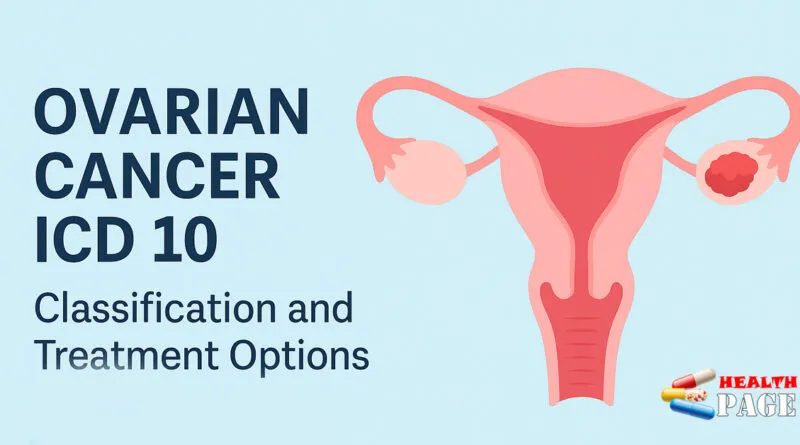Ovarian Cancer ICD 10: Classification and Treatment Options
Ovarian cancer is a serious disease that begins in the ovaries. It affects many women worldwide each year. Early detection is often difficult, which makes it more dangerous. Ovarian cancer can spread quickly if not diagnosed and treated early.
In healthcare, accurate diagnosis is essential for effective treatment. That’s where the ICD-10 system comes in. ICD stands for International Classification of Diseases, and version 10 is the latest standard. It is used by doctors, hospitals, and insurance companies around the world.
The term “ovarian cancer ICD 10” refers to the specific code used to classify ovarian cancer in medical records. This code helps track disease cases, plan treatment, and manage healthcare data. It also ensures that patients receive the right care based on their diagnosis.
This article will explain the meaning and purpose of the ovarian cancer ICD 10 code. You will learn how this code is used in classification and diagnosis. We will also explore common treatment options based on these codes. Understanding the ovarian cancer ICD 10 code can help patients and caregivers navigate the medical system more confidently.
The information is simple and easy to follow. Tables and charts will make the data clearer. Whether you are a patient, caregiver, or medical professional, this guide will help you understand the key role of ovarian cancer ICD 10 in modern healthcare.
Purpose of This Article:
- Define and explain ovarian cancer ICD 10 classification
- Show how ICD-10 aids diagnosis and healthcare planning
- Present treatment options based on ICD-10 codes
| ICD-10 Code | Description |
|---|---|
| C56 | Malignant neoplasm of ovary |
| C57.0 – C57.9 | Other female genital organs |
Understanding Ovarian Cancer

1.1 What Is Ovarian Cancer?
Ovarian cancer is the growth of abnormal cells in the ovaries. These cells multiply quickly and can spread to other organs. It is one of the most serious cancers in women.
Common symptoms include:
- Bloating that doesn’t go away
- Pelvic or abdominal pain
- Feeling full quickly when eating
- Weight loss
- Frequent urination
These symptoms are often vague and easy to ignore. That makes early detection difficult. Many women are diagnosed at later stages when treatment becomes harder.
1.2 Types of Ovarian Cancer
There are several types of ovarian cancer. Each begins in a different kind of cell.
1. Epithelial ovarian cancer:
This is the most common type. It starts in the cells that cover the outer surface of the ovary. It usually affects older women.
2. Germ cell tumors:
These are rare and start in the cells that produce eggs. They mostly occur in teenagers and young women.
3. Stromal tumors:
These begin in the ovarian tissue that contains hormone-producing cells. These tumors are often diagnosed at an earlier stage.
| Type | Common Age Group | Origin Cell |
|---|---|---|
| Epithelial | Older women | Surface of the ovary |
| Germ Cell | Teens/Young women | Egg-producing cells |
| Stromal | Any age | Hormone-producing tissue |
1.3 Risk Factors and Causes
Several factors increase the risk of ovarian cancer:
- Age: Risk increases after age 50
- Family history: Especially if close relatives had ovarian or breast cancer
- Genetic mutations: BRCA1 and BRCA2 genes raise risk significantly
- Hormonal factors: Early menstruation or late menopause
- Lifestyle: Obesity, smoking, and not having children can raise the risk
Ovarian Cancer ICD 10: Classification and Codes
2.1 What Is ICD-10?
ICD-10 stands for the International Classification of Diseases, 10th Revision. It is a global system created by the World Health Organization (WHO). Healthcare providers use it to record diseases and health conditions in a standard way.
Doctors, hospitals, and insurance companies use ICD-10 codes for:
- Diagnosis
- Medical billing
- Patient records
- Health data reporting
The ovarian cancer ICD 10 code plays a key role in all these areas. It ensures consistency and accuracy in healthcare services worldwide.
2.2 Ovarian Cancer ICD 10 Codes
The main ovarian cancer ICD 10 code is C56, which stands for malignant neoplasm of the ovary. This code is used to document primary ovarian cancer.
Below are more specific codes:
| ICD-10 Code | Description |
|---|---|
| C56.1 | Malignant neoplasm of right ovary |
| C56.2 | Malignant neoplasm of left ovary |
| C56.9 | Malignant neoplasm, unspecified ovary |
| C79.6 | Secondary malignant neoplasm of ovary (metastatic cancer) |
These codes help doctors pinpoint the exact location and type of ovarian cancer. That helps in choosing the right treatment plan.
2.3 Why Are ICD-10 Codes Important?
The ovarian cancer ICD 10 code is essential for many reasons:
- Ensures accurate diagnosis and correct treatment
- Supports smooth processing of insurance claims
- Helps researchers track cancer trends and outcomes
- Aids in managing hospital data and public health records
- Provides consistent terminology across countries
By using the correct ovarian cancer ICD 10 code, healthcare providers improve care and treatment outcomes for patients. It also allows global tracking of ovarian cancer cases, helping to improve awareness and research efforts.
Diagnosing Ovarian Cancer
3.1 Common Diagnostic Tests
To assign the correct ovarian cancer ICD 10 code, doctors must first confirm the diagnosis. Several tests help detect and confirm ovarian cancer.
1. Pelvic exam:
Doctors check the ovaries and nearby organs for lumps or changes in size or shape.
2. Transvaginal ultrasound:
This imaging test uses sound waves to view the ovaries closely. It helps detect abnormal growths or tumors.
3. Blood tests (CA-125):
CA-125 is a protein found in the blood. High levels can suggest ovarian cancer, but further tests are needed.
4. Imaging tests (CT or MRI scans):
These scans give detailed pictures of the ovaries and surrounding areas. They help check for tumor size and spread.
5. Biopsy:
A sample of tissue is removed and tested for cancer cells. It gives a confirmed diagnosis before treatment begins.
3.2 Staging Ovarian Cancer (FIGO System)
After confirming ovarian cancer, doctors use the FIGO system to stage the disease. Each stage helps determine the best treatment plan and the proper ovarian cancer ICD 10 code.
| FIGO Stage | Description |
|---|---|
| Stage I | Cancer is limited to one or both ovaries |
| Stage II | Cancer has spread to nearby pelvic organs |
| Stage III | Cancer has spread to the abdominal lining |
| Stage IV | Cancer has spread to distant organs (lungs, liver, etc.) |
Staging helps doctors understand how far the cancer has spread. It also influences the treatment strategy and survival rates.
Using the right ovarian cancer ICD 10 code depends on the stage and location of the cancer. Accurate staging ensures better care and supports proper insurance documentation.

Treatment Options for Ovarian Cancer
4.1 Surgery
Surgery is the first step in treating most cases linked to the ovarian cancer ICD 10 code. It helps remove as much cancer as possible.
Tumor debulking:
This surgery removes as much of the tumor as possible. It is often done before or after chemotherapy.
Hysterectomy:
This involves the removal of the uterus, ovaries, and fallopian tubes. It reduces the risk of cancer returning.
Surgical options depend on the stage and type identified using the ovarian cancer ICD 10 classification.
4.2 Chemotherapy
Chemotherapy is a common treatment after surgery. It helps kill any remaining cancer cells.
Common drugs include:
- Carboplatin
- Paclitaxel
These are given through an IV or as pills over several weeks.
Side effects may include:
- Nausea
- Fatigue
- Hair loss
- Risk of infection
Doctors often manage side effects with medications and rest. The ovarian cancer ICD 10 code helps guide drug choices and treatment length.
4.3 Radiation Therapy
Radiation is not commonly used for ovarian cancer. But in some rare cases, it may be helpful.
It uses high-energy beams to target and kill cancer cells. Radiation may be used if cancer returns or surgery isn’t possible.
4.4 Targeted Therapy and Immunotherapy
Some advanced ovarian cancers respond well to newer treatments.
Targeted therapy:
- PARP inhibitors (like olaparib) work for patients with BRCA gene mutations.
Immunotherapy:
- Bevacizumab is an anti-angiogenesis drug that blocks the growth of blood vessels feeding the tumor.
These options are tailored based on genetics, cancer stage, and the exact ovarian cancer ICD 10 classification.
4.5 Hormone Therapy
Hormone therapy is used mainly for stromal tumors. These tumors depend on hormones to grow.
Drugs may block or lower hormone levels in the body. This helps slow or stop tumor growth.
Each treatment plan is guided by the type and stage of cancer using the correct ovarian cancer ICD 10 code. Accurate coding ensures effective, targeted care for every patient.
Living with Ovarian Cancer
5.1 Managing Side Effects
Treatment for ovarian cancer can cause side effects that affect daily life. Knowing how to manage them is essential for recovery.
Common side effects include:
- Fatigue: Rest often, eat healthy, and stay active when possible.
- Nausea: Anti-nausea medications can help. Small, frequent meals may ease symptoms.
- Neuropathy: Numbness or tingling in hands and feet. Physical therapy and supplements may help reduce discomfort.
Managing these effects improves quality of life during and after treatment. The correct ovarian cancer ICD 10 code helps healthcare teams track and address symptoms properly.
5.2 Emotional and Mental Support
Living with ovarian cancer affects both the body and mind. Many patients experience anxiety, fear, or depression.
Helpful support options include:
- Counseling: Speaking to a therapist can ease emotional stress.
- Support groups: Connecting with other patients provides comfort and shared experiences.
- Mindfulness and meditation: These practices can reduce stress and improve mental clarity.
The journey with ovarian cancer is emotional. Ongoing care tied to the ovarian cancer ICD 10 classification includes mental health support as part of the treatment plan.
5.3 Follow-Up Care and Monitoring
After treatment, regular follow-up care is vital. It helps detect any signs of recurrence and monitors overall health.
Typical follow-up care includes:
- Regular check-ups: Physical exams to spot any new symptoms.
- Scans and blood tests: CA-125 levels and imaging help track cancer status.
- Medical history updates: Ensures all future care aligns with the correct ovarian cancer ICD 10 records.
Staying on schedule with follow-up visits increases long-term survival and peace of mind. Accurate documentation through the ovarian cancer ICD 10 code ensures proper long-term management and ongoing care.
Prevention and Early Detection
6.1 Can Ovarian Cancer Be Prevented?
While ovarian cancer cannot be fully prevented, certain steps can lower the risk. Early action is especially important for women with a family history.
Key prevention methods include:
- Genetic testing:
Women with BRCA1 or BRCA2 mutations have a higher risk. Testing helps identify those at risk early. - Oral contraceptives:
Long-term use of birth control pills may reduce the chance of developing ovarian cancer. - Preventive surgery:
Women at high risk may choose to remove ovaries and fallopian tubes to lower the risk.
All preventive strategies are based on personal and family history. Accurate risk assessments often involve data from the ovarian cancer ICD 10 code in medical records.
6.2 Importance of Early Screening
Ovarian cancer is often diagnosed late because early symptoms are vague. That’s why screening is vital—especially for high-risk women.
Recommended early detection steps:
- Regular pelvic exams:
Help detect any unusual growths or changes in the ovaries. - CA-125 blood tests and ultrasounds:
May be used for women with strong risk factors. - Genetic counseling:
Offers guidance on testing and prevention options for women with a family history.
Early detection improves outcomes and allows treatment to start sooner. Tracking symptoms and test results under the ovarian cancer ICD 10 code helps healthcare providers take timely action.
By understanding your risk and staying alert to changes, you can take control of your ovarian health.
Conclusion
In this article, we’ve explored the importance of the ovarian cancer ICD 10 code in diagnosing, classifying, and treating ovarian cancer. Accurate coding ensures that patients receive proper care and helps healthcare providers track the disease effectively. We discussed the various types of ovarian cancer, diagnostic tests, and treatment options, from surgery and chemotherapy to targeted therapies and immunotherapy.
Early detection is crucial for improving treatment outcomes. Regular screenings, especially for high-risk women, can make a significant difference in identifying ovarian cancer at an earlier stage. Knowing your risk factors and understanding the symptoms can also help you take preventive actions.
We encourage all women to stay informed about ovarian cancer and talk to their healthcare provider if they have concerns. If you or someone you know is at higher risk, don’t wait—consult a doctor about genetic testing or early screening options.
If you found this article helpful, please share it with others who may benefit from this information. Raising awareness is key to better outcomes for everyone affected by ovarian cancer.


